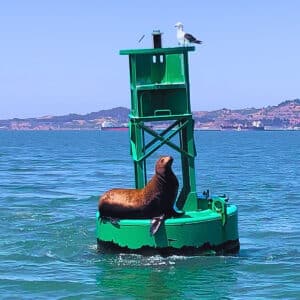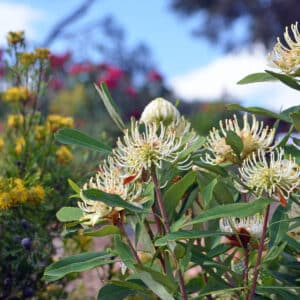A Guide to Protecting Our Local Wildlife and Ecosystem
When I am out boating on the Bay, I deeply get how easily we can take for granted the unparalleled natural beauty in our midst as Bay Area residents. I know for myself that it’s easy to get so caught up in the hustle of our city life that we can forget to pause and appreciate the wildness thriving in the green spaces, beaches, and bodies of water that make our region so special.
Boating on the San Francisco Bay delivers a dose of pure awe. That’s why moments like catching that blissed-out seal on a bouy, or pelicans diving for fish, or bottlenose dolphins frolicking at the surface are so profound when we stop to enjoy them. They jolt us back into remembering what an incredible privilege it is to call this area home. The Bay Area is a unique ecological biome where wildlife has managed to carve out their own “wild life” amid human development and activity. We’re so blessed to have a real-life wild kingdom right in our backyard – the vastness of San Francisco Bay and its diverse array of marine life.
frolicking at the surface are so profound when we stop to enjoy them. They jolt us back into remembering what an incredible privilege it is to call this area home. The Bay Area is a unique ecological biome where wildlife has managed to carve out their own “wild life” amid human development and activity. We’re so blessed to have a real-life wild kingdom right in our backyard – the vastness of San Francisco Bay and its diverse array of marine life.
While the urban amenities of San Francisco are world-class, there’s something grounding about witnessing nature’s splendor carried out by the resident wildlife living their own “wild life” in our local waters. We have a unique opportunity and responsibility to protect and preserve this natural treasure. Here are practical steps you can take in your daily life to contribute to the well-being of San Francisco Bay, its wildlife, and its ecosystem. Read to the bottom for more information on the organizations we mentioned and how you can get involved.
1. Reduce Plastic Use
Plastic pollution is a significant threat to marine life. Birds, fish, and seals can ingest or become entangled in plastic debris. You can help reduce plastic waste by:
- Using reusable bags, bottles, and containers: Bring your own bags to the grocery store, use a refillable water bottle, and pack lunches in reusable containers.
- Avoiding single-use plastics: Say no to plastic straws, cutlery, and packaging whenever possible.
2. Participate in Cleanups
Joining local cleanup efforts is a hands-on way to make a significant impact on the health of San Francisco Bay. Organizations such as Save The Bay and the Marine Mammal Center frequently organize cleanups. By participating, you can help remove harmful debris from our beaches and waterways.
- Save The Bay: This organization is dedicated to protecting and restoring the Bay. They offer volunteer opportunities for shoreline cleanups and habitat restoration.
- Marine Mammal Center: In addition to rescue and rehabilitation of marine mammals, they host beach
cleanups and educational events. We participate in their adopt-a-seal program. Currently, we have symbolically adopted a seal patient named Turbo from the Marine Mammal Care Center. She was a newborn who was found alone on the beach with many wounds, including a severe bone infection in her right front flipper. Through their adopt-a-seal program, our support provides Turbo with food and expert medical treatment to help her return to his ocean home. As an animal lover myself, I feel so lucky to be able to play a small part in Turbo’s successful rehabilitation.
3. Support Sustainable Seafood
Choosing sustainable seafood helps protect marine species and promotes healthy ocean ecosystems. Use resources like the Monterey Bay Aquarium’s Seafood Watch program to make informed choices about the seafood you eat.
- Monterey Bay Aquarium Seafood Watch: This program provides recommendations on which seafood to buy or avoid, helping you make environmentally responsible choices.
4. Use Eco-Friendly Products
The products you use at home can have a direct impact on the environment. When we opt for biodegradable and non-toxic cleaning and personal care products, we help to prevent harmful chemicals from entering the Bay.
- Green Seal and EPA’s Safer Choice: Look for these certifications when purchasing products to ensure they meet environmental safety standards.
5. Conserve Water
Water conservation reduces the amount of runoff and wastewater that enters the Bay. Simple changes in our daily habits can make a big difference:
- Fix leaks: Repair dripping faucets and running toilets to save water.
- Shorten showers: Aim for five-minute showers.
- Don’t let water run when brushing your teeth.
- Fill up the dishwasher before running it.
- Use water-efficient appliances: Install low-flow shower heads and toilets, and consider water-efficient dishwashers and washing machines.
6. Proper Disposal of Waste
Improper disposal of hazardous materials can lead to pollution in the Bay. We should espacially ensure that we dispose of items like batteries, paints, and motor oil at designated collection points.
- San Francisco Department of the Environment: This department provides information on where and how to safely dispose of hazardous waste.
7. Plant Native Species

- California Native Plant Society: This organization offers resources and advice on planting native species that thrive in our local climate and support wildlife.
8. Educate and Advocate
Raising awareness about the importance of preserving San Francisco Bay is crucial. We like to spread awareness and invite you to talk to friends and family about conservation efforts, and support policies that protect our fragile environment.
- Baykeeper: An organization focused on stopping pollution in the Bay. They offer ways to get involved and advocate for stronger environmental protections.
- Sierra Club San Francisco Bay Chapter: Engage in local advocacy efforts to protect the Bay and its surrounding habitats.
- The Marine Mammal Center: This organization rescues and rehabilitates seals, sea lions and other marine mammals, runs a broad spectrum of educational services for the public and animal veterinary professionals, Adopt a seal for just $10 a month and save the wildlife!
9. Use Public Transportation
Public transportation in the Bay Area is not the best or most convenient, but there are times when it can be used and reducing our carbon footprint helps decrease pollution that can negatively affect water quality in the Bay. Opt for public transportation, biking, or carpooling whenever possible.
- San Francisco Municipal Transportation Agency (SFMTA): Provides comprehensive public transit options to help reduce individual car usage.
- Ferry System: There are ferries now that run from San Francisco to the East Bay, Marin to the City, Vallejo to the City, Richmond to the City. These are a great way to not only help with keeping a smaller foot print, but the sites are beautiful and the fresh air revitalizing.
- Bike Paths across the bridges
10. Participate in Citizen Science
Engaging in local wildlife monitoring programs allows you to contribute to important conservation research efforts. These programs often involve tracking animal populations, documenting environmental changes, and more.
- Golden Gate National Parks Conservancy: Offers citizen science opportunities such as bird counts and habitat monitoring.
- California Academy of Sciences: Hosts citizen science projects that anyone can participate in, contributing valuable data to ongoing research.
Protecting San Francisco Bay is a collective effort that starts with our individual actions. By making conscious choices in our daily lives and supporting local organizations dedicated to environmental conservation, we can ensure that the Bay remains a vibrant and healthy ecosystem for future generations.
Every action we take counts, whether we’re reducing our plastic use, participating in cleanups, or advocating for stronger environmental policies, When we come together as a community to preserve the natural beauty and ecological health of San Francisco Bay, we thrive.
For more information on how you can get involved, visit the following organizations:
- Save The Bay
- Marine Mammal Center
- Monterey Bay Aquarium Seafood Watch
- San Francisco Department of the Environment
- California Native Plant Society
- Baykeeper
- Sierra Club San Francisco Bay Chapter
- Golden Gate National Parks Conservancy
- California Academy of Sciences
- Passage Nautical
- Get Your Blue Mind On
Together, we can make a difference and ensure that the San Francisco Bay remains a sanctuary for wildlife and a source of pride for our community. 🌊🦭
#ProtectOurBay #EcoFriendlyLiving #WildlifeConservation
 cleanups and educational events. We participate in their adopt-a-seal program. Currently, we have symbolically adopted a seal patient named Turbo from the Marine Mammal Care Center. She was a newborn who was found alone on the beach with many wounds, including a severe bone infection in her right front flipper. Through their adopt-a-seal program, our support provides Turbo with food and expert medical treatment to help her return to his ocean home. As an animal lover myself, I feel so lucky to be able to play a small part in Turbo’s successful rehabilitation.
cleanups and educational events. We participate in their adopt-a-seal program. Currently, we have symbolically adopted a seal patient named Turbo from the Marine Mammal Care Center. She was a newborn who was found alone on the beach with many wounds, including a severe bone infection in her right front flipper. Through their adopt-a-seal program, our support provides Turbo with food and expert medical treatment to help her return to his ocean home. As an animal lover myself, I feel so lucky to be able to play a small part in Turbo’s successful rehabilitation.